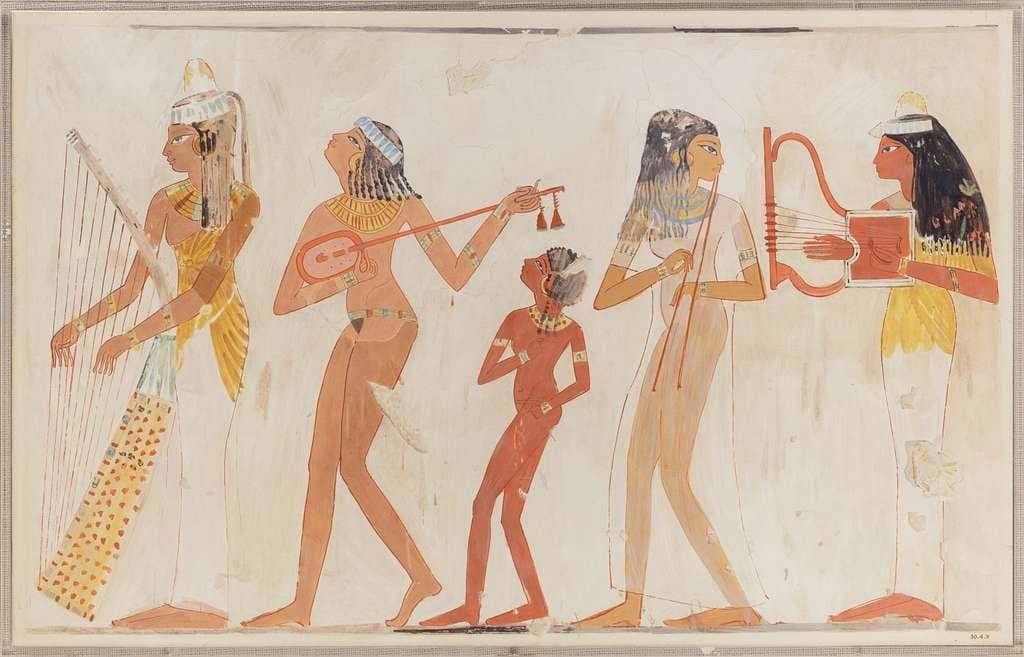Jump Ahead to
ToggleACOUSTIC GUITAR HISTORY
The modern acoustic guitar’s history is a testament to the instrument’s enduring legacy and adaptability. By blending tradition with innovation, acoustic guitars have secured their place as one of the most cherished and versatile musical instruments of all time.
The Ancient Mesopotamian

Even though we call it acoustic guitar now, if we go back to the timeline, there are so many types of instrument which actually was similar to our so-called acoustic guitar. From the acoustic guitar history, the timeline says that the concept of stringed instruments started in between 3500 BC and 3200 BC which was a cylinder shape. It has been traced through an engraving by Dr. Dominique Collon from the region of Mesopotamia in Iraq, that a woman playing a fretless, short neck plucked Lute type instrument. The lute instrument were popular in Arabic culture during that time.
The Ancient Egyptians, Greeks and Persians are considered as the pioneer of stringed instrument. Though With the passage of time the first type of stringed instrument is lost but the oldest surviving guitar like instrument TANBUR from egypt is still in our present world since 1500 BC. a court singer by the name of Har-mose was the owner of this instrument who sang for the egyptian queen Hathepsut. This is a three string fretted and a pear shape soundbox. During that time, Most of the instruments were simple and made from the materials like wood, bone and animal gut.
Ancient Greek and The Roman Empire

As a part of acoustic guitar history, the lute instrument played an important role in the creation of the acoustic guitar. Since 700 BC string instrument ‘Kithara’ had become prominent in ancient greece. The word ‘Guitar’ is also known to be originated from the greek word ‘Kithara’. The Kithara is an instrument of Lyre family which was made up of 7 strings on a wooden body. This instrument was mostly played by the professional musicians in Greek public which became popular by the end of 7th century BC.
Since 40 AD, the romans entered spain and brought the kithara with them. During that time, the kithara became synonymous with western european culture. Later on in 711AD, which is known as the start of Moorish invasion, a nomadic people from North Africa brought their ouds with them. The characteristics of the oud and cithara combined by the europeans adding frets to the oud which was named as “Laud” in spanish.


These two instrument have significant similarities with the modern day acoustic guitar. Both of the instrument had string which need to be plucked or strummed by hand to generate sound and having a hollow box which helps to produce and amplify sound. After a few centuries the Vihuela was invented which played a secondary role in the development of acoustic guitar.
Development of Modern Acoustic Guitar

The journey of modern acoustic guitar started from the renaissance period in 1488. The german book ‘The Heidelberger Totentanz’ was published which having around 38 prints showing the figure of a skeleton holding stringed instruments of the time(The lute, Vihuela and Renaissance Guitar) and trying to impress a woman. The picture of this book confirm the existence of instruments in 1488. Afterwards, by the 16th century a fretted and plugged string instrument had become popular among troubadours and minstrels in europe. They started performing for the crowds in taverns and town squares by travelling accompanied by other instruments like the harp.


The popularity of guitar started to expand during Baroque period in the 17th and 18th century as other instruments started to be invented like piano and violin. Through this period the body of the guitar became narrower, and the strings were made of gut instead of silk which actually made the guitar more louder and resonant. In 19th century the spanish guitar maker Antonio de Torres Jurado developed the modern classical guitar. Afterwards in 1920s, Matin introduced the dreadnought, which was capable to produce larger sound and it became the standard acoustic guitar design which we follow till today…
